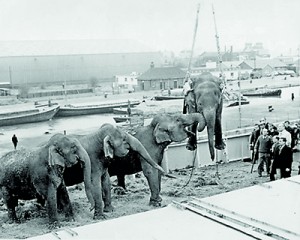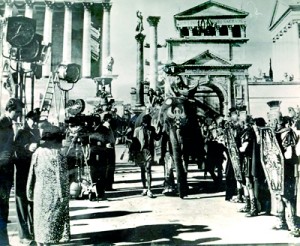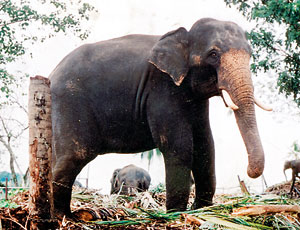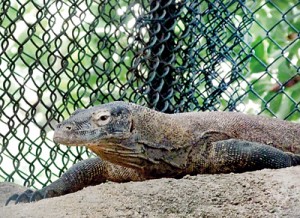An obituary for long-dead elephants

The touching picture that caught the writer’s eye
My girlfriend and I found these four elephants framed in a photograph in a bar last week in London. It was clear to us that the animals had arrived in our city by sea, but when and from where? I decided to seek out their story. Here’s what I found…
The photo was much more recent than I had imagined — it showed London’s South West India Docks in 1968. I had assumed the elephants were new arrivals from Asia but they had come to England 20 years earlier and were just returning from their latest overseas trip. These animals had names. From left to right that’s Sally, Lelia, Mary and — in the sling — Camella.
For now though, focus on the man with the stick. His name was John Chipperfield and his family had been putting on shows with performing animals since the 17th century. Back in 1684 John’s ancestor James William Chipperfield held his first animal shows during the Frost Fair that took place on London’s River Thames, whose surface often froze solid in the midwinters all those years ago.
Two centuries later, his descendant James Frances Chipperfield (1846-1917) would often boast: “I can train anything from a rabbit to an elephant.” Future generations of Chipperfields would forgo the former to lead with the latter.
In 1947, Dick Chipperfield travelled to Sri Lanka and began to buy the big beasts. First up was six-year-old Camella, the one hanging from the harness in the photograph. Next was Mary. Chipperfield bought her from a rubber plantation where she was herself training a younger elephant to fetch and carry. Later he found Sally, whose forehead bump meant good luck in Sri Lanka.
That year the Chipperfields shipped 21 Sri Lankan elephants to England, a journey of several weeks on high seas that I imagine would have disconcerted the creatures. One of them died at sea just two days into the journey. By December the rest were performing in a circus at Harringay Arena in north London, where today a Carphone Warehouse stands. Hollywood legend Mae West was among the many people who saw the elephants there that winter.
Nine years later, in 1956, Sally, Lelia, Mary and Camella were part of a large group of elephants that the Chipperfields sent to Ireland to entertain new audiences. The circus sold several of the touring party to new owners there but brought these four females back to England. Mary was then sent to Rome in 1963 to star in the movie Cleopatra, with Elizabeth Taylor riding on her back (seen above, far right).
A couple of years later Mary made an even longer journey, again with Sally, Lelia and Camella who by now had been together for nearly 20 years. All four were in a group the Chipperfields sent to tour Southern Africa between 1965 and 1967. The photograph I saw last week showed them upon their return to London. It was the beginning of the end for this well-travelled quartet. Camella died the following year. The others became known as The Big Three and performed together for another decade. Mary survived until 1978. Sally and Lelia were both at the circus when a fire broke out in 1979 and died soon after as a result.
Around this time reports of cruelty to elephants began to emerge from circuses around the world. A report from the Humane Society of the United States lists several cases in which keepers beat elephants with hooks, or otherwise failed to care for their health and welfare. It includes reports on the famed Chipperfield dynasty, for which the era ended in ignominy.
Between 1997 and 1998 activists secretly filmed staff at the headquarters of Mary Chipperfield Promotions beating elephants. Their footage led to a public backlash against animal circuses. Elephant keeper Steve Gills was jailed for cruelty in 1998. The following year, a court found Mary Chipperfield and her husband Richard Cawley guilty of animal cruelty too — she for abusing a chimpanzee, he for whipping a sick elephant. Then in 2000 The Mirror newspaper claimed that Mary’s cousin Dickie Chipperfield had treated elephants

Performing for the cameras: One of the elephants, Mary, was sent to Rome in 1963 to appear in the movie Cleopatra starring Elizabeth Taylor
cruelly — to which he reportedly replied: “There are elephants treated worse in India, you know.”
Cruelty continues. PETA says 29 elephants have died in the care of a single circus in the United States in the past 20 years. Meanwhile, the keepers of England’s last circus elephant face cruelty charges that stem from another case of undercover filming. If these things can happen today, then what did performing elephants endure decades ago when animal welfare was a little-known concept and whistleblowers were rare.
The elephants whose photograph I saw last week had already lived through 20 years of training and touring when that photo was taken. They had spent weeks at sea and had returned to face another chapter of a life in chains. As my girlfriend and I peered closer at that picture we noted the way the three standing elephants all faced towards the fourth, as it hung suspended in mid air. But what really pulled us into the picture was the way one elephant had reached out its trunk to touch the one being lifted away.
Elephants are intelligent, social creatures and they touch each other like that with purpose. Perhaps the animals in the photograph were aware that their imminent upheaval might be more than merely physical.
Any comments on this article could be sent to Mike Shanahan’s blog: http://underthebanyan.wordpress.com/2012/10/19/an-obituary-for-long-dead-elephants/
Follow @timesonlinelk
comments powered by Disqus
























